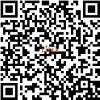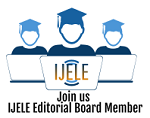(2) * Ika Maryani
(3) Cindy Joe Sanjun
(4) Dwi Sulisworo
(5) Trianik Widyaningrum
(6) Achadi Budi Santosa
*corresponding author
AbstractThis study is motivated by the low environmental literacy and academic achievement of elementary school students. The study aims to measure the effect of Android-based STEM-AR on students' environmental literacy. A quantitative research method with a One Group Pretest-Posttest Design was used. A total of 31 fifth-grade elementary school students in Yogyakarta, Indonesia, were randomly selected from nine public schools. The research instruments included a lesson plan and an Augmented Reality (AR) medium accessible via Android smartphones. STEM was used as a reference for structuring subject matter. The treatment was conducted four times, each lasting 70 minutes. Students' environmental literacy was measured before and after the treatment using a validated multiple-choice test. Data analysis employed a t-test with a 5% significance level. The Paired Sample Test results showed a sig(2-tailed) value of 0.001 < 0.05, which led to the rejection of the null hypothesis and acceptance of the alternative hypothesis. This study contributes to proving that Android-based STEM-AR positively influences elementary school students' environmental literacy.
KeywordsEducation; Elementary school; Environmental literacy; STEM-AR
|
DOIhttps://doi.org/10.31763/ijele.v7i1.1818 |
Article metrics10.31763/ijele.v7i1.1818 Abstract views : 396 | PDF views : 16 | PDF views : 57 |
Cite |
Full Text Download Download
Full Text Download Download
|
References
[1] J. Kim and S. J. Ryu, “Enhancing Sustainable Design Thinking Education Efficiency: A Comparative Study of Synchronous Online and Offline Classes,†Sustain., vol. 15, no. 18, pp. 1–18, 2023, doi: 10.3390/su151813293.
[2] D. J. Rivers, M. Nakamura, and M. Vallance, “Online Self-Regulated Learning and Achievement in the Era of Change,†J. Educ. Comput. Res., vol. 60, no. 1, pp. 104–131, Jun. 2021, doi: 10.1177/07356331211025108.
[3] D. R. Krathwohl and L. W. Anderson, “A taxonomy for learning, teaching, and assessing: A revision of Bloom’s taxonomy of educational objectives,†Theory Pract., vol. 41, no. 4, p. 212, 2001.doi: 10.1207/s15430421tip4104_2
[4] I. Maryani, I. N. Fitriani, and D. Sulisworo, “The science encyclopedia based on characters to improve the natural science concepts understanding in elementary school students,†in Journal of Physics: Conference Series, 2019, vol. 1318, no. 1, p. 012016, doi: 10.1088/1742-6596/1318/1/012016.
[5] J. Parong and R. E. Mayer, “Journal of Educational Psychology: Editorial,†J. Educ. Psychol., vol. 94, no. 4, p. 659, 2002, doi: 10.1037//0022-0663.94.4.659.
[6] H. İ. Yıldırım, “The Effect of Using Out-of-School Learning Environments in Science Teaching on Motivation for Learning Science,†Particip. Educ. Res., vol. 7, no. 1, pp. 143–161, 2020, doi: 10.17275/per.20.9.7.1.
[7] E. S. Smit, M. H. C. Meijers, and L. N. van der Laan, “Using virtual reality to stimulate healthy and environmentally friendly food consumption among children: An interview study,†Int. J. Environ. Res. Public Health, vol. 18, no. 3, pp. 1–13, 2021, doi: 10.3390/ijerph18031088.
[8] S. Pe’er, G. Daphne, and B. and Yavetz, “Environmental Literacy in Teacher Training: Attitudes, Knowledge, and Environmental Behavior of Beginning Students,†J. Environ. Educ., vol. 39, no. 1, pp. 45–59, Sep. 2007, doi: 10.3200/JOEE.39.1.45-59.
[9] W. Castillo-González, C. O. Lepez, and M. C. Bonardi, “Augmented reality and environmental education: strategy for greater awareness,†Gamification Augment. Real., vol. 1, pp. 1–10, 2023, doi: 10.56294/gr202310.
[10] S. Kumari and N. Polke, “Implementation Issues of Augmented Reality and Virtual Reality: A Survey BT - International Conference on Intelligent Data Communication Technologies and Internet of Things (ICICI) 2018,†2019, pp. 853–861. doi: 10.1007/978-3-030-03146-6_97
[11] X. Xu and F. and Ke, “Designing a Virtual-Reality-Based, Gamelike Math Learning Environment,†Am. J. Distance Educ., vol. 30, no. 1, pp. 27–38, Jan. 2016, doi: 10.1080/08923647.2016.1119621.
[12] D. Bogusevschi, C. Muntean, and G.-M. Muntean, “Teaching and Learning Physics using 3D Virtual Learning Environment: A Case Study of Combined Virtual Reality and Virtual Laboratory in Secondary School,†J. Comput. Math. Sci. Teach., vol. 39, no. 1, pp. 5–18, Jan. 2020. doi: 10.70725/297454nsjryb
[13] I. Lee and B. Perret, “Preparing High School Teachers to Integrate AI Methods into STEM Classrooms,†Proc. 36th AAAI Conf. Artif. Intell. AAAI 2022, vol. 36, pp. 12783–12791, 2022, doi: 10.1609/aaai.v36i11.21557.
[14] F. Benita, D. Virupaksha, E. Wilhelm, and B. Tunçer, “A smart learning ecosystem design for delivering Data-driven Thinking in STEM education,†Smart Learn. Environ., vol. 8, no. 1, 2021, doi: 10.1186/s40561-021-00153-y.
[15] S.-J. Lu and Y.-C. Liu, “Integrating augmented reality technology to enhance children’s learning in marine education,†Environ. Educ. Res., vol. 21, no. 4, pp. 525–541, May 2015, doi: 10.1080/13504622.2014.911247.
[16] J. Buchner, K. Buntins, and M. Kerres, “The impact of augmented reality on cognitive load and performance: A systematic review,†J. Comput. Assist. Learn., vol. 38, no. 1, pp. 285–303, Feb. 2022, doi: 10.1111/jcal.12617.
[17] N. Tuli and A. and Mantri, “Evaluating Usability of Mobile-Based Augmented Reality Learning Environments for Early Childhood,†Int. J. Human–Computer Interact., vol. 37, no. 9, pp. 815–827, May 2021, doi: 10.1080/10447318.2020.1843888.
[18] A. Markula and M. Aksela, “The key characteristics of project-based learning: how teachers implement projects in K-12 science education,†Discip. Interdiscip. Sci. Educ. Res., vol. 4, no. 1, p. 2, 2022, doi: 10.1186/s43031-021-00042-x.
[19] I. Radu, “Augmented reality in education: a meta-review and cross-media analysis,†Pers. Ubiquitous Comput., vol. 18, no. 6, pp. 1533–1543, 2014, doi: 10.1007/s00779-013-0747-y.
[20] C. Muali, P. Setyosari, Purnomo, and L. Yuliati, “Effects of Mobile Augmented Reality and Self-Regulated Learning on Students’ Concept Understanding,†Int. J. Emerg. Technol. Learn., vol. 15, no. 22, pp. 218–229, 2020, doi: 10.3991/ijet.v15i22.16387.
[21] Y. Georgiou and E. A. Kyza, “Relations between student motivation, immersion and learning outcomes in location-based augmented reality settings,†Comput. Human Behav., vol. 89, pp. 173–181, 2018, doi: 10.1016/j.chb.2018.08.011.
[22] M. Fidan and M. Tuncel, “Integrating augmented reality into problem based learning: The effects on learning achievement and attitude in physics education,†Comput. Educ., vol. 142, p. 103635, 2019, doi: 10.1016/j.compedu.2019.103635.
[23] E. M. Janssen et al., “Training higher education teachers’ critical thinking and attitudes towards teaching it,†Contemp. Educ. Psychol., vol. 58, pp. 310–322, 2019, doi: 10.1016/j.cedpsych.2019.03.007.
[24] B. G. Bergman, “Assessing impacts of locally designed environmental education projects on students’ environmental attitudes, awareness, and intention to act,†Environ. Educ. Res., vol. 22, no. 4, pp. 480–503, May 2016, doi: 10.1080/13504622.2014.999225.
[25] N. Pellas, A. Dengel, and A. Christopoulos, “A Scoping Review of Immersive Virtual Reality in STEM Education,†IEEE Trans. Learn. Technol., vol. 13, no. 4, pp. 748–761, 2020, doi: 10.1109/TLT.2020.3019405.
[26] D. Glaroudis, A. Iossifides, N. Spyropoulou, I. D. Zaharakis, and A. D. Kameas, “STEM Learning and Career Orientation via IoT Hands-on Activities in Secondary Education,†2019 IEEE Int. Conf. Pervasive Comput. Commun. Work. PerCom Work. 2019, no. 710583, pp. 480–485, 2019, doi: 10.1109/PERCOMW.2019.8730759.
[27] K. Adhelacahya, Sukarmin, and Sarwanto, “The Impact of Problem-Based Learning Electronics Module Integrated with STEM on Students’ Critical Thinking Skills,†J. Penelit. Pendidik. IPA, vol. 9, no. 7, pp. 4869–4878, 2023, doi: 10.29303/jppipa.v9i7.3931.
Refbacks
- There are currently no refbacks.
Copyright (c) 2025 Dwi Sulisworo

This work is licensed under a Creative Commons Attribution-ShareAlike 4.0 International License.

International Journal of Education and Learning
ISSNÂ 2684-9240
Published by Association for Scientific Computing Electronics and Engineering (ASCEE)
W : http://pubs2.ascee.org/index.php/ijele
E : zalik@ascee.org

This work is licensed under a Creative Commons Attribution-ShareAlike 4.0 International License.





















